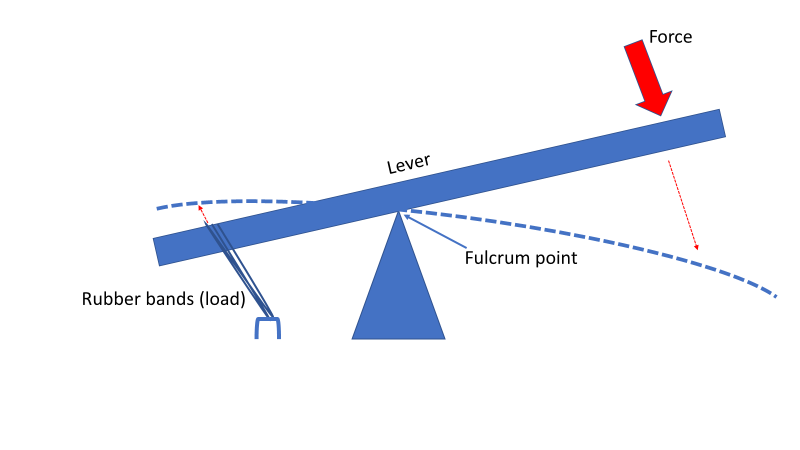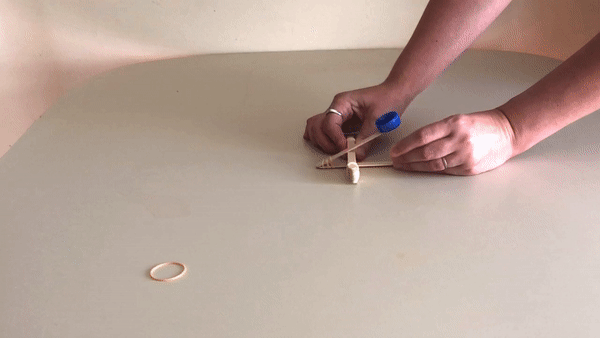Make a simple catapult that can fire small items across rooms. Students can invent games to play and experiment with their catapults and test their understanding of potential and kinetic energy.
Learning Intentions
Students will use the scientific process identify and understand potential and kinetic energy, their use to do work and how energy can be transferred from one form to another. Students will how the use of energy, in this case potential and kinetic energy, has been used to develop technologies and affect the world they live in.
Download pdf of Catapult activity
Materials
- Icy pole sticks
- Rubber bands
- Bottle cap (optional)
- Glue/sticky tape (optional)
Method
- Get a stack of 5 – 8 icy pole sticks, depending on how high you want your catapult to be. Secure both ends by wrapping rubber bands around them.
- Slide another icy pole stick between the bottom two sticks in the stack. Slide it so that only a small part is sticking out of the stack, with most of it sticking out in the other direction.
- Attach the bottle cap to the end of another icy pole stick – the lever. The bottle cap holds the projectile easier.
- Place the lever icy pole stick on top of the stack. Use a rubber band to secure the end of the lever without the bottle cap to the stick coming from out the bottom of the stack. The point on the lever where it pivots up and down over the stack is called the fulcrum point.
- Push the top and bottom icy pole sticks through the stack so they spread out. Note, this changes the fulcrum point and angle of the lever.
- Put something small in the bottle cap, pull the lever down and let it go. Watch your item fly.
Warning: the catapult will fling things with some force. Avoid using projectiles that can cause damage or harm such as marbles. Try marshmallows, pom poms, peanuts.
Variations
Vary the fulcrum point of the lever stick. Note how shifting the fulcrum point changes the angle of the lever stick. To be consistent among the catapults, you might want to make 5mm marks along the lever stick so each student is comparing the effect of the same fulcrum point. Alternatively, use a protractor to measure the angle of the lever stick. What effect does this have on distance and height the projectile reaches? Ensure also that when comparing the catapults you have the same number of icy pole sticks in the stack.
Go bigger: Replace the icy pole sticks with 30cm wooden or plastic rulers. Does plastic or wood work better?
Increase the tension in the rubber bands holding the lever and bottom stick by adding one or more extra loops around the stick. What effect does this have on the distance and height of the projectile? See Figure 1 below.

Figure 1. Lever showing the load, fulcrum point and force. The load in this instance is the rubber bands holding down one end of the lever. We will assume the lever has some elasticity and therefore potential energy alongside the potential energy in the rubber bands. Applying force to the lever on the other side of the Fulcrum point from the load will provide tension in the rubber bands and lever. Releasing the force on the lever will release that energy in the form of kinetic energy (movement) as the lever and rubber bands return to their natural shape. The projectile is not bound to the lever so it will continue to as a projectile to its target. Note the lever where the force is applied moves over a much greater distance than the load end. As the fulcrum point moves closer to the load the mechanical advantage of the lever increases or the force required to achieve an effect on the load is decreased. In other words, it is easier to lift the load when the fulcrum point is closer to the load.
Results
Create a table to record distance and height of your launched projectile according to the number of icy pole sticks in your stack, the different fulcrum points (or angle of your lever) and the number of twists/tension (or loops) in your rubber band that hold the end of the catapult.
What effect did increasing the tension on the rubber band have?
What effect did shifting the fulcrum point have?
What form of catapult flung a projectile the farthest distance?
Can you graph your results? For example, distance travelled by projectile against the position of fulcrum point (noted by measurement mark on the lever stick), or angle of the lever.
What is happening
What can you say about what is happening based on your results. For example, how does increasing the tension on the rubber band or the position of the fulcrum point affect the distance or height of the projectile.
There are two types of energy involved in a catapult: Potential and kinetic energy. Potential energy is stored energy and kinetic energy is movement.
The energy to do the work in a catapult – fling stuff across the room – is the potential energy stored in the tension in the lever stick and rubber bands that you create by bending the icy pole stick and stretching the rubber band.
A bow and arrow work on a similar principle. You can fling an arrow because of the stored tension you create in the bow when you pull back on the bowstring to bend the bow.
In our catapult, when you bend the lever stick and stretch the rubber bands and let it go you release all the stored energy in the lever stick and rubber band in one go. In other words, the potential energy in the rubber bands and lever stick is transferred to kinetic energy – or movement.
The fulcrum point
The fulcrum point in our catapult sits between the force and the load. The load is applied by the rubber bands – how many you have, or how many loops you placed around the sticks. The force is what you apply to the end of the lever stick that holds the projectile.
The closer your fulcrum point is to the load the greater force can be applied to the load. Students should be able to notice that it is easier to apply greater tension to the lever stick and rubber bands the closer the fulcrum is to the load, which is the rubber bands holding the lever stick and bottom stick together.
On a normal lever, the load might be a weight you place at one end of the lever and the force will be what you apply to the other end in an attempt to lift that load. Think about a see-saw. The fulcrum point is in the middle. Imagine you place one student on the end of the see-saw. Where along the see-saw is easiest to push the see-saw down to raise the student in the air? It should be the point furthest along the see-saw from where the student is sitting. Test the idea out when you next find a see saw.
Think about where else you think fulcrum points are used to help humans do work. Think about levers, for example how do you use a spoon to open the lid from a tin? The spoon is the lever, the fulcrum point is where the spoon rests on the lip of the tin. You apply a downward force on the end of the spoon to lift the lid off. What would make the job of removing the lid easier: a shorter or longer spoon?
In a see-saw the distance you will push down will be the same as the student sitting on the other end will go up because the fulcrum is in the middle of the see-saw. In the example of the spoon and lid, the distance you will push the spoon down will be far greater than the distance the other end of the spoon will need to rise to lift the lid because the fulcrum point is only a short distance from the load (lid).
Apply what you have learned from the above to how you might design your catapult to send a projectile the furthest.
Have some fun
Students can build castles, with targets in and around the castle. Each target can be worth different amount of points, depending on the perceived difficulty to hit the target with a catapult projectile. Students can then design what they consider to be the best catapults based on what they have learned to see who is best at hitting the targets. For example, the design of catapult to launch a projectile over a castle wall might have to be different than a design that will launch a projectile that will hit a target on the castle wall itself. Student could make up their own rules, but consider giving each student 10 identical projectiles to fire at the targets. The student or team with the most points after firing all ten projectiles wins.
For extended thinking and worksheets, see the downloadable pdf
Back to FLEET Schools or All Home Science activities.

